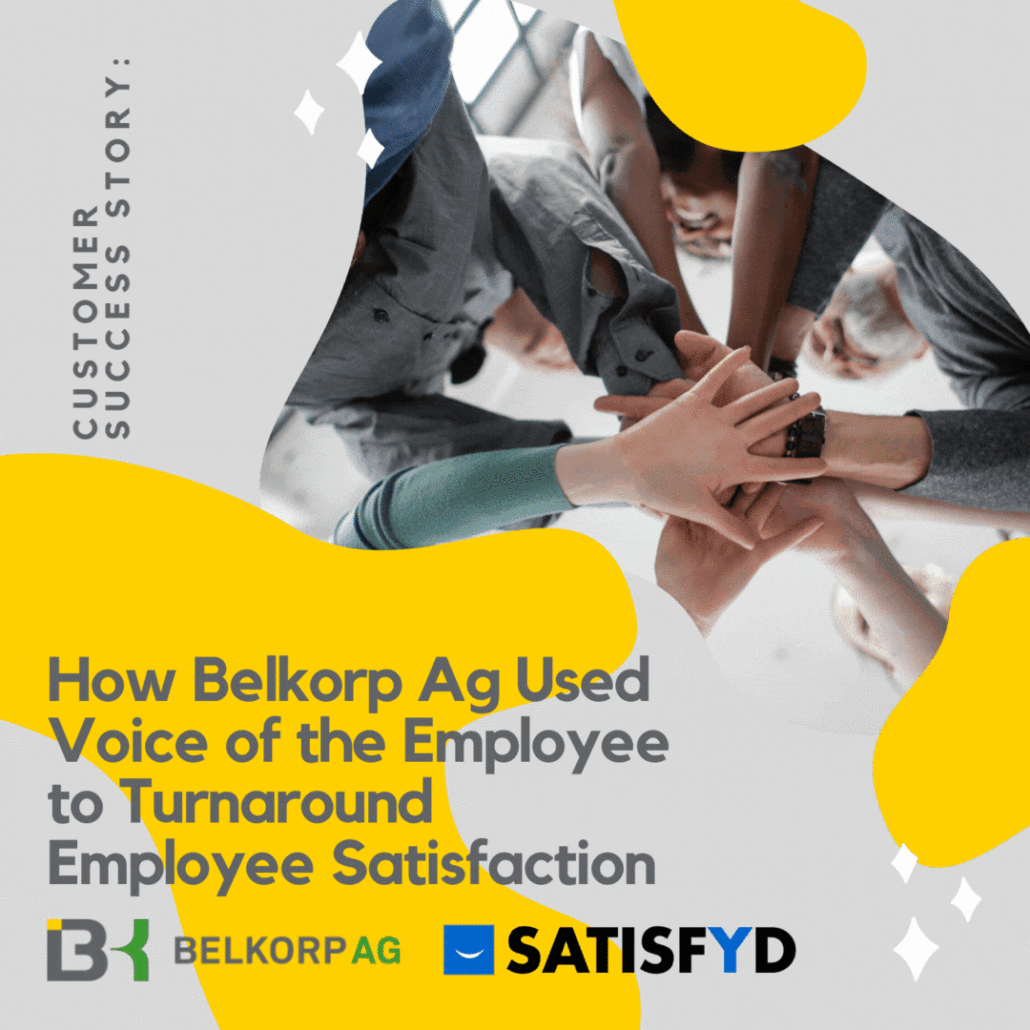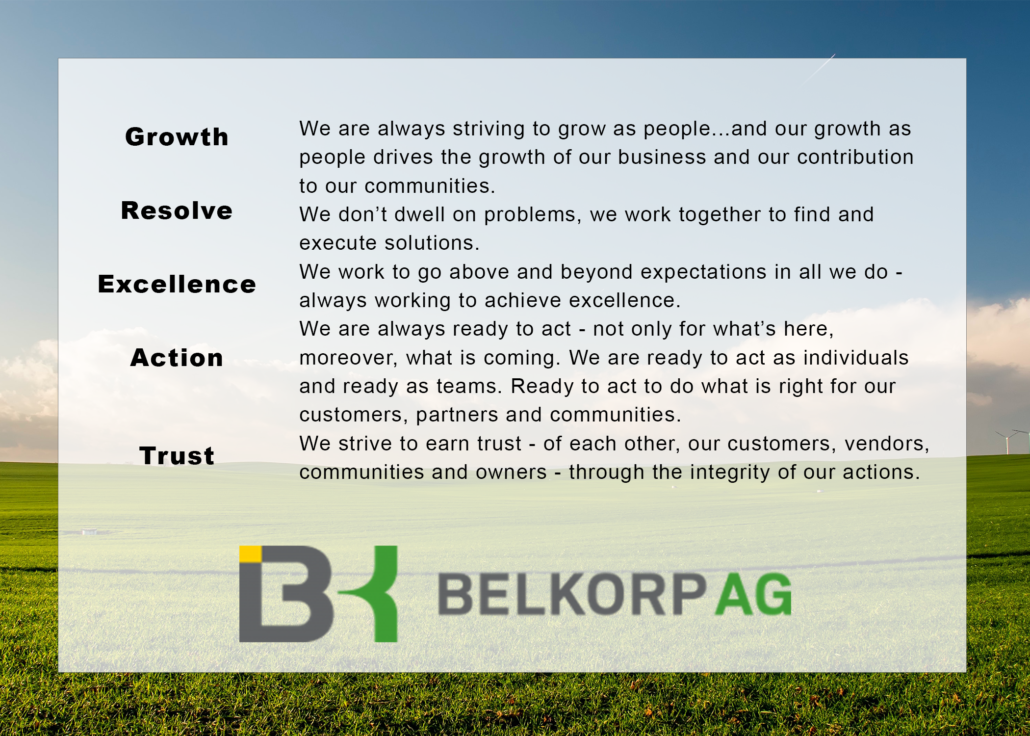Customer Success Story:
How Belkorp Ag Used Voice of the Employee to Turnaround Employee Satisfaction
Belkorp’s focus on employee satisfaction leads to increased employee retention, customer satisfaction and improved dealership performance in sales and service.
Introduction
Dealerships today are under increased pressure to improve performance in both sales and service. Sales are now so tightly tied to service contracts that it is no longer effective to focus only on sales metrics; it’s important that customers are happy throughout the lifetime of their equipment contracts. Read about how Belkorp Ag used SATISFYD’s Voice of the Employee program to drive initiatives that saw increased employee retention and customer satisfaction across every location helping the company turn around a lagging employee base to an engaged and motivated team that is proactively engaged and responsive, leading to Belkorp Ag’s Modesto location being recognized as one of the best places to work in the region.
Company Snapshot
The Belkorp Group of Companies is a 2nd generation family-owned business located in Vancouver, BC. Belkorp’s origins date back to the 1940’s. The Belkorp Group has grown over the past decades and has diversified holdings throughout the United States and Canada. Belkorp Ag was formed in 2011 to acquire the Deere dealerships located in Modesto and Patterson, California. Since 2011, Belkorp Ag has expanded to 7 locations in the North Coast and Central Valley and is supported by over 180 employees today.
Belkorp Ag is led by Nathan Green whose vision when he took on Belkorp Ag in 2013 was to lead the company to excellence in sales and service representing the John Deere brand. Green, who had joined the Belkorp group of companies four years prior, was determined to drive growth of Belkorp Ag based on a set of values that would drive the success from the ground up. Green’s philosophy remains that to be great for customers, the organization must be a great place to work for the employees.
The Challenge
In October 2015, Trish Smith joined Belkorp Ag as their Director of HR. Belkorp Ag was struggling to bring 7 different dealerships that had been independently operating into one streamlined company culture. Smith brought to the table fifteen years of experience working in Human Resources with a keen eye on employee success and retention.
When Smith joined the team, the company was assessing the results of an employee survey powered by SATISFYD’s Voice of the Employee service. The company had distributed over 185 surveys to employees in order to identify areas that could be improved.
The results came in and the executive team quickly recognized that they had some improvements to make on employee engagement and satisfaction. The team also knew that if these improvements were not made, it would put at risk the company’s core values; without employee buy-in and support these values company-wide were at risk.
The Solution
With the view to improving employee morale and loyalty, Smith used the survey results to address areas where the company was struggling. To drive that morale boost and loyalty, Smith recognized that the first thing they needed to do was to address the biggest pain points organizationally. Smith did this by focusing on each location, as well as initiating programs that were run company-wide.
Smith met with every location manager and then addressed their three lowest scores and developed action plans that would address these problem areas. Many locations had issues that were easy to address by implementing a level of visibility to an issue. In addition, employees were guided to processes that had been available but that for any number of reasons, had been overlooked as a pathway to resolution. Employee problems were addressed by implementing a culture shift to a more proactive approach. Belkorp empowered employees to resolve issues independently using the various tools and management processes that were, in many cases, already in place but underutilized.
As these more location-centric fixes were implemented, Smith and her team also recognized from their survey results that there was a communication disconnect between the senior management and location management decision-making process and the employees that were most often impacted by new initiatives. Employees were resistant to change because they did not understand why a change was being made. Employees viewed many changes as an inconvenience and an interruption to how they had been working previously. The senior team had been so busy with streamlining, that timely communication from the top down had not been fully followed through to the frontline team. To address this, leadership was provided training in employee communication training through Dale Carnegie. Smith also established Employee Engagement Teams that consisted of herself and non-management team members representing every department and location. By having representation from every location, Smith strived to minimize the possibility of disconnecting with any team member at any Belkorp Ag location. To foster a culture of trust and openness, Smith did not invite any of the Belkorp Ag leadership to participate in the team’s monthly meetings.
The employee engagement teams met monthly to increase both visibility into management decisions as well as provide timely feedback to the management team on ongoing issues. At first, the meetings were focused on troubleshooting organizational issues and providing solutions to proactive, independent resolutions. One area of focus for the team was to increase and improve the communication from Senior Management to the Store Managers to Supervisors to employees. The team did this by implementing a regular weekly Huddles at each location that would allow for information to be shared and disseminated with team members. They quickly learned that by sharing the ‘why’ behind management decisions, their teams were able to be more supportive and adoption of new initiatives was maximized with much greater resistance to changes needed. This positive impact trickled down to customer communications; employees were now empowered to communicate to customers why they do something a specific way.
The team also established an anonymous feedback form, called Everyone Speaks, that provided employees a safe way to provide suggestions, address concerns or provide feedback. A big part of the success of this form was also providing a space to not only share issues and anonymous concerns but to provide a way for peer-based employee recognition. This was important to the Belkorp Ag senior management team to align with the Be G. R. E. A. T. core values. Our employees started to recognize each other for going above and beyond through this form. This feedback loop was a way to share gratitude and recognition provided by team members to relate to this communication tool as a resource for good, not just to spotlight the bad.
As the team drove continued success in implementing change in the organization by addressing specific pain points, they were able to start a transition of their role from being a one-way communications program to a two-way communications function. Company-wide Microsoft Teams-based discussion channels were created that would provide a greater level of communication, visibility and most importantly, inviting participation.
Since the team had already demonstrated success organization-wide, employees are able to trust changes, having seen how many of the team’s initiatives had led to a more cohesive organization. Employees felt empowered to participate, knowing that their voices were heard. Employees at every level were being recognized for the contributions they made which may have gone unnoticed by management as well as providing an opportunity for all employees to share these successes. In 2019 there were over 140 employees recognized by their peers for their contribution to the company’s success. Success is considered a team effort and to that point, every quarter, the company publishes all employee recognition in its newsletter which is distributed both at the locations and mailed to employees’ homes so that the entire family and/or personal network can see and appreciate the recognition received.
Today the employee engagement team is able to help drive change by engaging with employees to provide input on company initiatives on every level. They have grown to include a safety team to ensure that every aspect of the business is addressed. In 2021, the team plans to add Wellness as a focus to their employee engagement team and will continue to look for areas that they can drive ongoing employee engagement and satisfaction.








